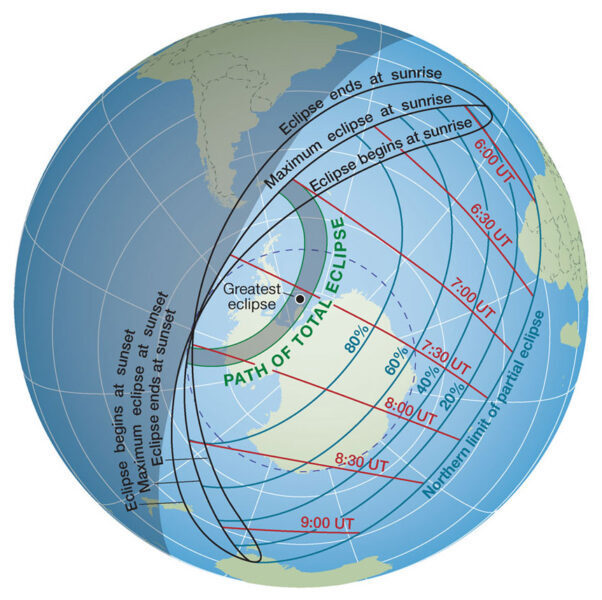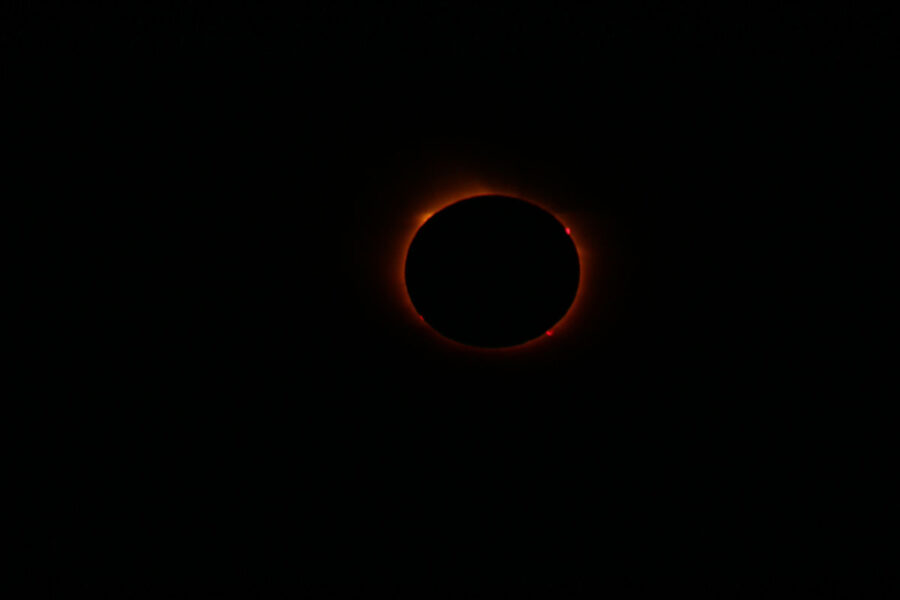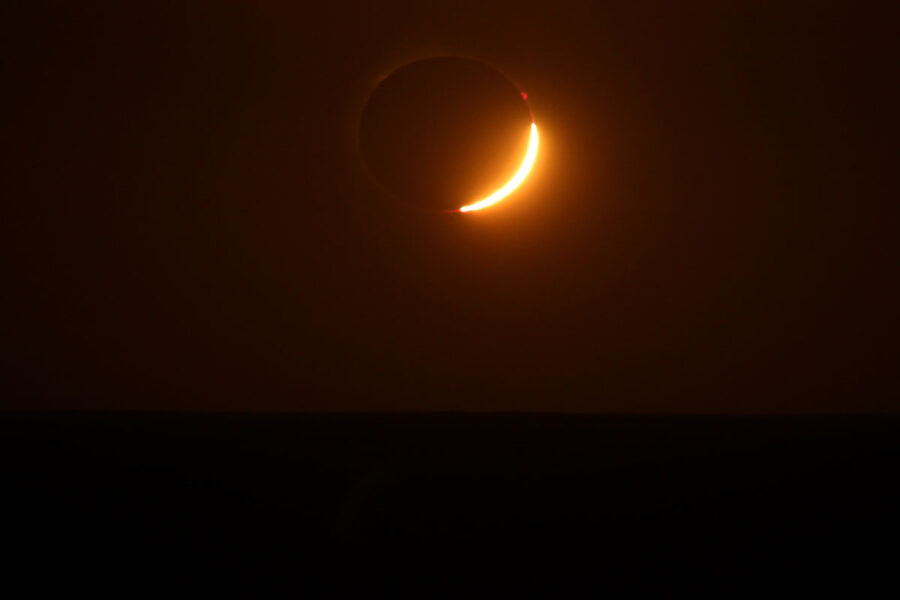11.12.2021
Sky & Telescope and friends report on the total solar eclipse that occurred over Antarctica earlier this week.
AN ANTARCTIC ECLIPSE ADVENTURE
Early morning on December 4th, a few thousand adventurous travelers crowded the decks of cruise ships, boarded specially chartered planes, or stepped out into Antarctica’s frigid air — all with their hearts thumping in anticipation of astronomy’s greatest spectacle: a total eclipse of the Sun.
The Moon’s narrow shadow reached Earth’s surface at a very oblique angle that day, creating a skinny but stretched-out oval of darkness over ground and sea. The shadow swept rapidly across the Southern Ocean, offering up to 1.9 minutes of totality in the frozen Antarctic terrain surrounding the Weddell Sea.
December 4th’s event was unusual in two important respects. First, totality occurred in the most sparsely populated region of the entire planet. Land-wise, the path of the Moon’s dark shadow touched only Antarctica and the tiny South Orkney Islands as it swept across Earth. Only a few thousand people were positioned to see it. Meanwhile, the only inhabited places that got to see even a partial solar eclipse were on the southern tip of Africa, Tasmania, and bits of southeastern Australia and New Zealand’s South Island.
Second, the eclipse track mostly crossed the longitudinal hemisphere of Earth facing away from the Sun, during what would ordinarily be nighttime hours. However, because the event happened just a few weeks before the December solstice, the portions of Antarctica that lay within the path were experiencing constant daylight. Because of this unusual “over the pole” eclipse geometry, the Moon’s shadow didn’t sweep west to east in longitude, as it usually does, but instead raced west to east as it crossed Antarctica.

Judy Anderson
According to Jay Anderson, a Canadian meteorologist who specializes in eclipse-day weather, those on Antarctica had the best chance of seeing the eclipse, whereas the odds of success were against anyone venturing by ship to the accessible locations of the Southern Ocean.
In the end, the most daring eclipse-chasers — those who ventured to the outpost at Union Glacier in Antarctica (79°46′S, 83°16′W) — had the best views. From there, the gloriously eclipsed Sun sat 14° above the horizon at roughly local midnight, though viewers had to witness it in the brutal cold of late “spring,” near –20°C (–4°F).
Success also came for two groups of eclipse-junkies who took to the sky from Punta Arenas, Chile, aboard a pair of chartered 787 Dreamliners. The planes smoothly maneuvered into the path of totality at the cloud-free height of about 40,000 feet and offered unique views not only of the solar corona but also of the dark umbral cone surrounding it.
Yet even this seemingly straightforward gambit was fraught with complications, as international safety rules and a revoked landing permit forced the Chilean airline LATAM to save the expedition by providing a last-minute switch from smaller Airbus A321 aircraft to the longer-range (and much pricier) 787s.

Judy Anderson
Meanwhile, down at sea level, a small armada of 15 expedition-class cruise ships had taken up positions within the umbral path in the hope of beating the poor-weather odds. One of those, Hurtigruten Expeditions’ ms Roald Amundsen, carried a Sky & Telescope group hosted by Contributing Editor Bob King.
Despite the maneuverability that such ships offer, mostly the clouds won out. Only one ship, National Geographic Endurance, caught sight of totality. Perhaps logically, this ship had Anderson and his wife Judy aboard.
“Oh, what a beautiful morning!!” exclaimed Judy Anderson afterward. “The crescent rose from the sea in a wedge of clear sky, and thinned rapidly to show the corona while the first diamond was visible at 2nd contact. . . . And all too quickly, the second diamond was there (flattened rather than brilliant cut!) and 3rd contact took us back to the thin crescent. Very, very shortly afterward, the tip of the crescent went into the looming bank of cloud. Phew!!”

Judy Anderson
All those who ventured deep into the Southern Hemisphere for December 4th’s event will have to be patient to see totality again, as 2022 offers no total solar eclipses. The next one will be April 20, 2023, and will once again require a long journey: western Australia and Indonesia.
That event will be unusual in that it offers both an annular (ring) eclipse at the path’s ends, and up to 76 seconds of totality — what is sometimes termed a “hybrid” solar eclipse — in the middle. Hopeful eclipse-chasers will most likely be found in ships off the western and northern coasts of Australia (the path barely clips Australia itself at its northwesternmost corner), or perhaps on one of the islands of Indonesia.
Quelle: Sky&Telescope
